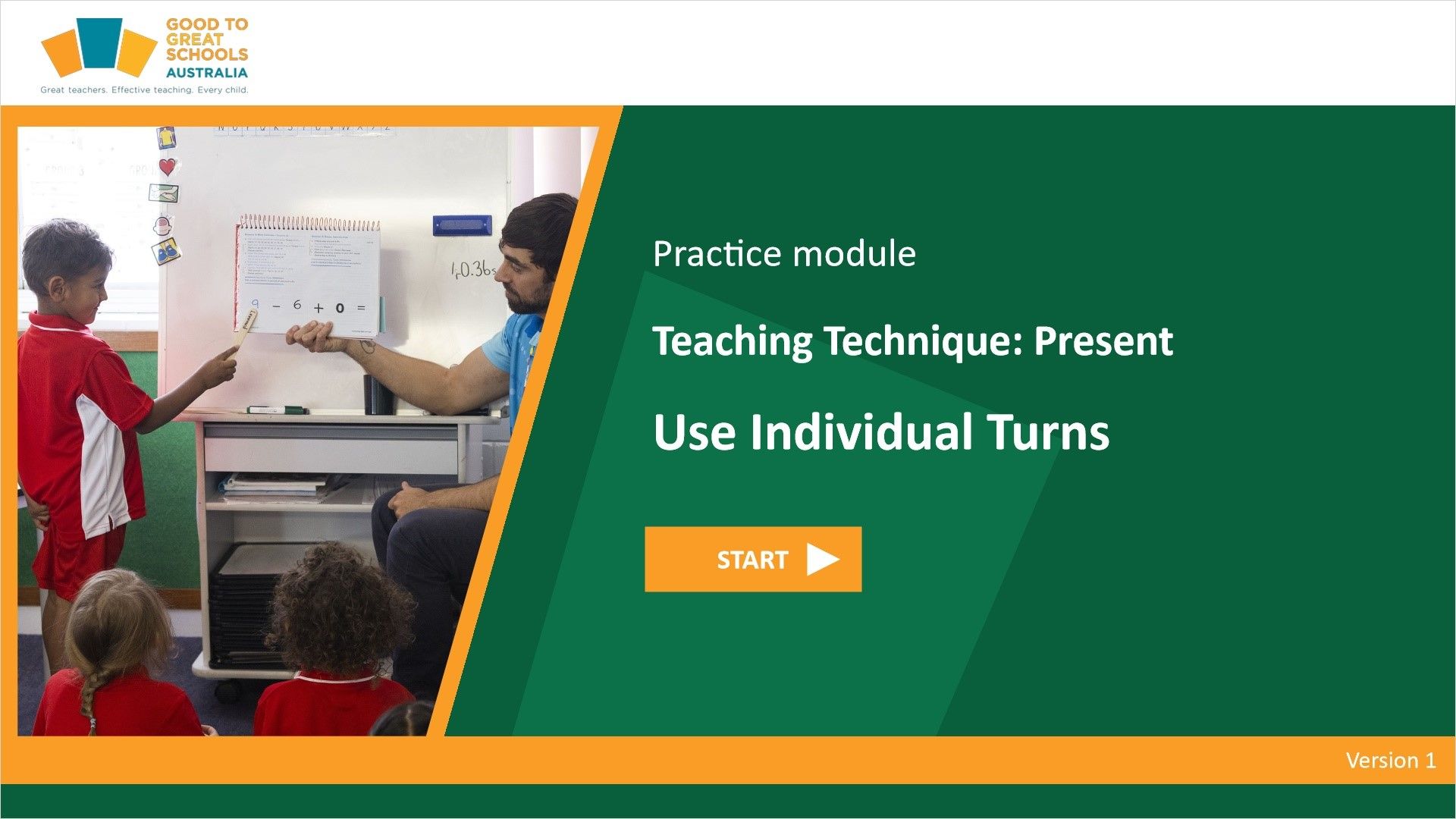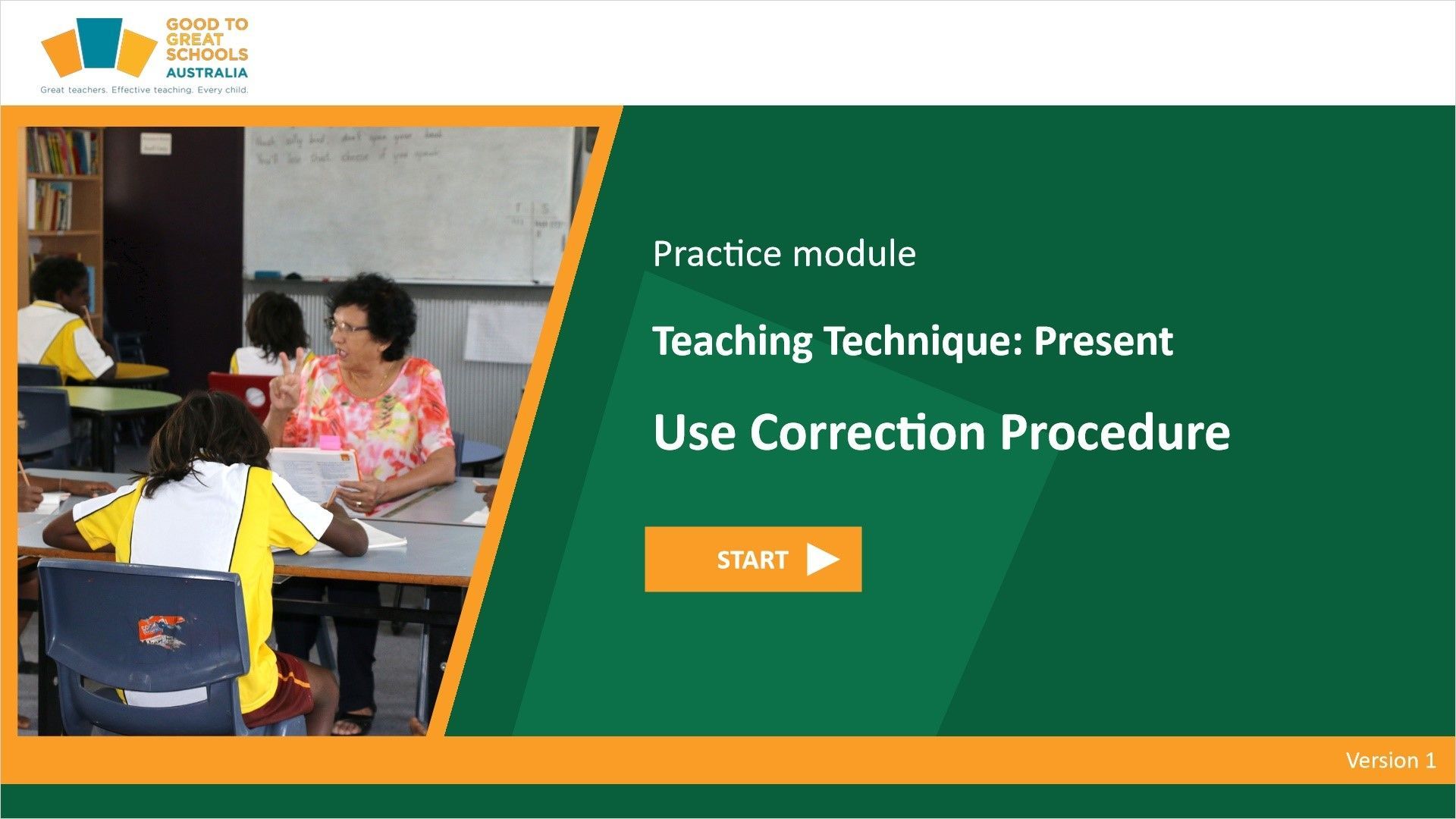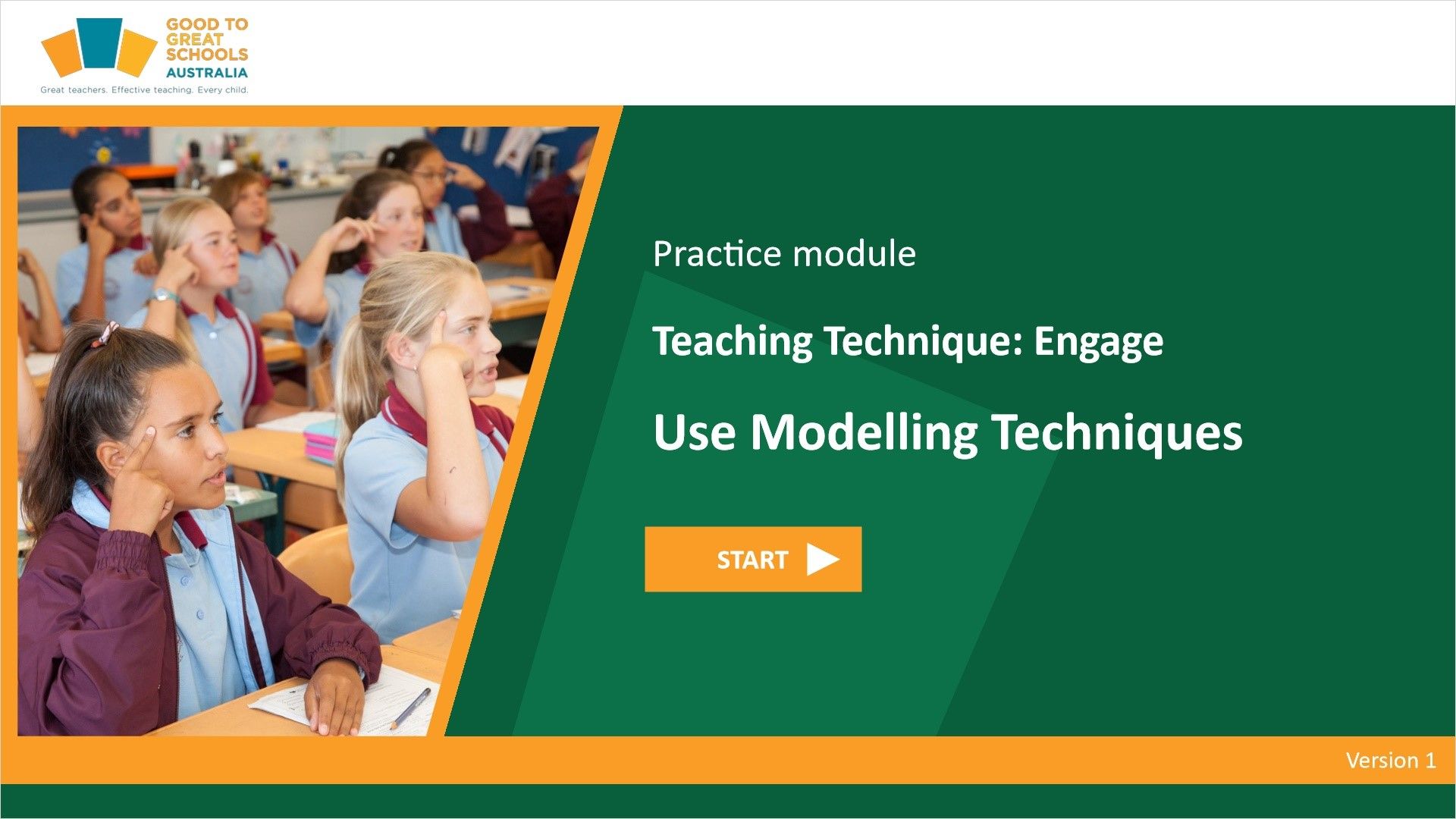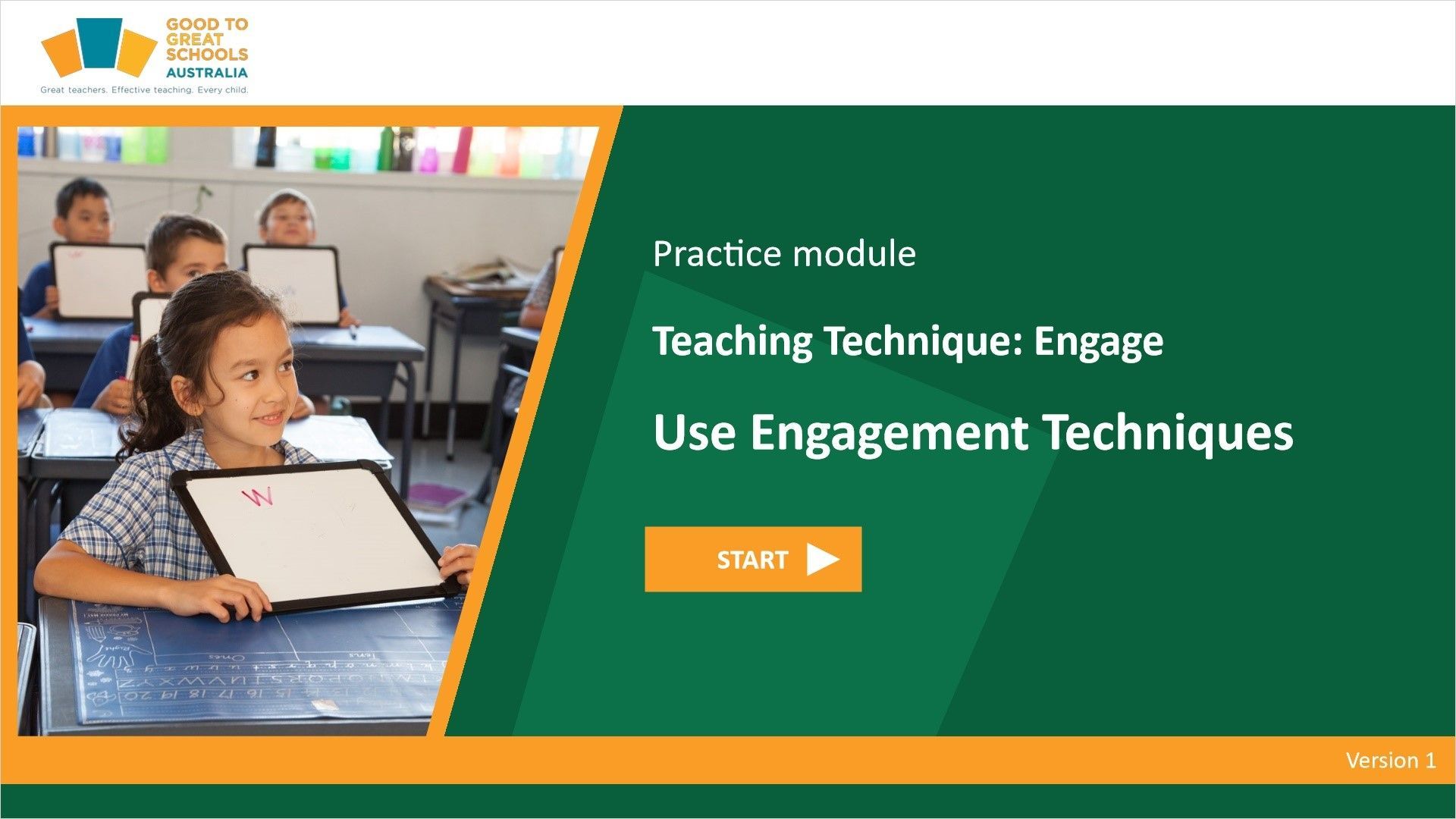Teaching Technique: Model (We Do)
Practice Modules
Overview

Present: Use Individual Turns
Use Individual Turns is a practice module that goes in-depth into what happens when the technique is delivered with fidelity. Participants learn what happens when using individual turns is not delivered with fidelity and how to overcome the barriers to delivering instruction using individual turns with fidelity.
Learning Intents
- Demonstrate techniques that engage students and deliver lesson components to fidelity (TS1.2) (3.1.02).
- Understand basic direct instruction techniques and why they are used. Understand basic explicit instruction teaching techniques and why they are used. Demonstrate mastery of basic direct and explicit instruction techniques through weekly program practice sessions and then in classroom delivery (TS1.3) (3.1.03).
- Understand components of effective teaching resources (such as the Teacher Guide) that align with core programs. Communicate correct use of program components, such as Teacher Presentation Book, Teacher Guide, Student Workbooks, student books, etc. (TS1.4) (3.1.04).
- Implement lesson sequences with fidelity, maintaining student engagement and promoting learning (TS1.9) (3.1.09).
- Review key teaching techniques with colleagues in weekly practice sessions (TS1.10) (3.1.10).
- Understand basic effective teaching techniques and practices in academics and behaviour. Demonstrate ability to teach lessons using direct and explicit instruction teaching techniques (TS2.1) (3.2.01).
- Plan lesson presentation using direct and explicit instruction teaching techniques. Implement all parts of direct and explicit instruction lessons (TS2.7) (3.2.07).
- Plan group instruction based on mastery data and program guidelines. Implement direct and explicit instruction lessons with fidelity (TS4.8) (3.4.08).
Duration
- 4 Lessons.
Assessment
Assessment has two stages:
- Test: Knowledge and skills taught in the lessons
- Observation: Delivery with students of the knowledge and skills learned in the lessons.
Certification
- None.

Present: Use Correction Procedure
Use Correction Procedure is a practice module that goes in-depth into what happens when the technique is delivered with fidelity. Participants learn what happens when using the correction procedure is not delivered with fidelity, the barriers and how to overcome them to deliver using the correction procedure with fidelity.
Learning Intents
- Demonstrate techniques that engage students and deliver lesson components to fidelity (TS1.2) (3.1.02).
- Understand basic direct instruction techniques and why they are used. Understand basic explicit instruction teaching techniques and why they are used. Demonstrate mastery of basic direct and explicit instruction techniques through weekly program practice sessions and then in classroom delivery (TS1.3) (3.1.03).
- Understand components of effective teaching resources (such as the Teacher Guide) that align with core programs. Communicate correct use of program components, such as Teacher Presentation Book, Teacher Guide, Student Workbooks, student books, etc. (TS1.4) (3.1.04).
- Implement lesson sequences with fidelity, maintaining student engagement and promoting learning (TS1.9) (3.1.09).
- Review key teaching techniques with colleagues in weekly practice sessions (TS1.10) (3.1.10).
- Understand basic effective teaching techniques and practices in academics and behaviour. Demonstrate ability to teach lessons using direct and explicit instruction teaching techniques (TS2.1) (3.2.01).
- Plan lesson presentation using direct and explicit instruction teaching techniques. Implement all parts of direct and explicit instruction lessons (TS2.7) (3.2.07).
- Plan group instruction based on mastery data and program guidelines. Implement direct and explicit instruction lessons with fidelity (TS2.8) (3.2.08).
Duration
- 4 Lessons.
Assessment
Assessment has two stages:
- Test: Knowledge and skills taught in the lessons
- Observation: Delivery with students of the knowledge and skills learned in the lessons.
Certification
None.

Engage: Use Modelling Techniques
Use Modelling Techniques is a practice module that goes in-depth into what happens when the technique is delivered with fidelity. Participants learn what happens when using modelling techniques is not delivered with fidelity, the barriers and how to overcome them to deliver using modelling with fidelity.
Learning Intents
- Demonstrate techniques that engage students and deliver lesson components to fidelity (TS1.2) (3.1.02).
- Understand basic direct instruction techniques and why they are used. Understand basic explicit instruction teaching techniques and why they are used. Demonstrate mastery of basic direct and explicit instruction techniques through weekly program practice sessions and then in classroom delivery (TS1.3) (3.1.03).
- Understand components of effective teaching resources (such as the Teacher Guide) that align with core programs. Communicate correct use of program components, such as Teacher Presentation Book, Teacher Guide, Student Workbooks, student books, etc. (TS1.4) (3.1.04).
- Implement lesson sequences with fidelity, maintaining student engagement and promoting learning (TS1.9) (3.1.09).
- Review key teaching techniques with colleagues in weekly practice sessions (TS1.10) (3.1.10).
- Understand basic effective teaching techniques and practices in academics and behaviour. Demonstrate ability to teach lessons using direct and explicit instruction teaching techniques (TS2.1) (3.2.01).
- Plan lesson presentation using direct and explicit instruction teaching techniques. Implement all parts of direct and explicit instruction lessons (TS2.7) (3.2.07).
- Plan group instruction based on mastery data and program guidelines. Implement direct and explicit instruction lessons with fidelity (TS2.8) (3.2.08).
Duration
- 4 Lessons.
Assessment
Assessment has two stages:
- Test: Knowledge and skills taught in the lessons
- Observation: Delivery with students of the knowledge and skills learned in the lessons.
Certification
None.

Engage: Use Engagement Techniques
Use Engagement Techniques is a practice module that goes in-depth for participants to learn what happens when the technique is delivered with fidelity. They learn what happens when using engagement techniques is not delivered with fidelity, including the barriers and how to overcome them to deliver using engagement techniques with fidelity.
Learning Intents
- Demonstrate techniques that engage students and deliver lesson components to fidelity (TS1.2) (3.1.02).
- Understand basic direct instruction techniques and why they are used. Understand basic explicit instruction teaching techniques and why they are used. Demonstrate mastery of basic direct and explicit instruction techniques through weekly program practice sessions and then in classroom delivery (TS1.3) (3.1.03).
- Understand components of effective teaching resources (such as the Teacher Guide) that align with core programs. Communicate correct use of program components, such as Teacher Presentation Book, Teacher Guide, Student Workbooks, student books, etc. (TS1.4) (3.1.04).
- Implement lesson sequences with fidelity, maintaining student engagement and promoting learning (TS1.9) (3.1.09).
- Review key teaching techniques with colleagues in weekly practice sessions (TS1.10) (3.1.10).
- Understand basic effective teaching techniques and practices in academics and behaviour. Demonstrate ability to teach lessons using direct and explicit instruction teaching techniques (TS2.1) (3.2.01).
- Plan lesson presentation using direct and explicit instruction teaching techniques. Implement all parts of direct and explicit instruction lessons (TS2.7) (3.2.07).
- Plan group instruction based on mastery data and program guidelines. Implement direct and explicit instruction lessons with fidelity (TS2.8) (3.2.08).
Duration
- 4 Lessons.
Assessment
Assessment has two stages:
- Test: Knowledge and skills taught in the lessons
- Observation: Delivery with students of the knowledge and skills learned in the lessons.
Certification
None.
